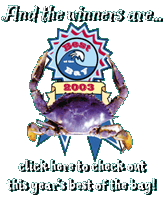Letters to the Editor
We welcome your letters and opinions. We will edit when necessary. Include your name, address and phone number for verification. Mail them to Bay Weekly, P.O. Box 358, Deale, MD 20751 • E-mail them to us at [email protected].
Your Say: A New Oyster for Our Bay?
Dear Bay Weekly:
First, I believe it is necessary to identify the problem and in a word, it’s pollution: sedimentary (mud), biological and chemical.
Second, the causes. Again in a word, it’s people. Tens of millions of people in the Chesapeake watershed are responsible for all three sources mentioned above.
Third and last: how to deal with it? We can both treat the problem as it exists, and we can prohibit the addition of more pollutants. Believe the latter will work? Neither do I. There is no way tens of millions of people will work diligently in concert to stop polluting. Make book on it!
People equal pollution, pure and simple. Look at the roads. Hours after they are cleaned up by pick-up crews, the litter abounds. No, I’m afraid that approach is doomed. We need to clean up the mess — again — without the auspices of humans. The rapid decline of water quality in the Bay coincides with the decline in oysters. And oysters declined due to water quality: an endless cycle. Here again people are the cause, through over-harvesting and poisoning the water.
People are not going to be the solution, directly. It has to be oysters. But the native Virginia oyster is finished. It can’t handle MSX, Dermo, sediment and dissolved poisons all at once. In spite of years of the best efforts of public and private organizations, the oyster population has slid to one percent (that’s one percent) of it’s historic numbers, without a prayer of coming back, in spite of what you may hear.
But the savior in the wings may well be the Asian oyster, crassostrea ariakensis, which can handle the diseases that lay old C.Virginica low. They may also be better able to handle the human adversary as well, due to a more rapid growth rate. Ariakensis actually thrives in the dilute cesspool of the Chesapeake.
What are we waiting for? Sure, there have been mistakes in the past with ill-advised introductions of flora and fauna, but they were accidental or thoughtless occurrences. Foreign introduction does not necessarily mean trouble. Look at the ringneck pheasant, tulips, Japanese yews and countless more. These Asian oysters are a much needed introduction with little to lose and much to gain, since it appears to be the only viable way to clean up Bay water. The oysters of historic times filtered the volume of the entire Bay in a few days. Today’s population couldn’t filter a cove in a year.
Ideally, I would not entertain returning to commercial oystering for a considerable time after the waters clear — if they ever do. No oyster industry will suffer because there is virtually none now and won’t ever be without the better water that ariakensis can bring.
It’s time to get off our collective duffs and take action while there is a chance to save the rest of the aquatic population of the Bay.
That’s my two cents, and I thank you.
— Dave Gauntt, St. Leonard
If You Can Get ‘Em, Freeze ‘Em.
Dear Bay Weekly:
I was guided to your Bay Weekly Web site [www.bayweekly.com] through a general search of “oyster.” I am from South Carolina and love to eat my share of seafood, especially oysters. As you know, we can’t get oysters year round. There are times even in warmer weather that I would really enjoy a good oyster stew. My question is, can canned oysters be frozen? I know they can, but in what condition will they be when thawed?
— Larry Beavers: [email protected]
Editor’s reply: Shucked oysters freeze so well that they can be used in any recipe as well as eaten raw. They’ll be quite moist when thawed, so for some recipes they’ll need drying on a paper towel.
Be sure when you freeze them to leave plenty of air space for expansion, about one-quarter of the height of the container in which you’re freezing them. Canned raw oysters leave far less head room, so repackage before freezing.
to the top

